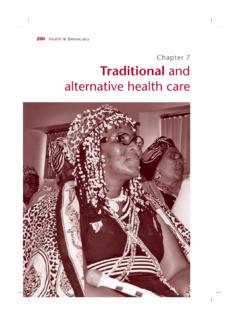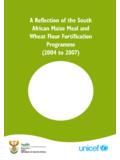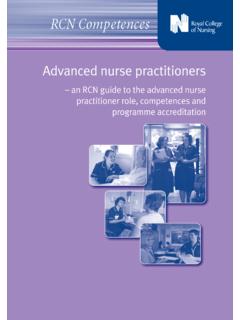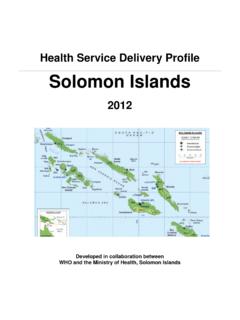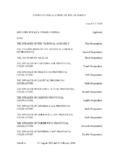Transcription of Colonic Irrigations: A Review of the Historical ... - I-ACT
1 1 Colonic Irrigations: A Review of the Historical controversy and the potential for Adverse Effects Douglas G. Richards, , David L. McMillin, , Eric A. Mein, , Carl D. Nelson, Abstract Colonic irrigations enjoy widespread popularity in the alternative medicine community, while being viewed with considerable skepticism by the conventional medical community. While proponents make claims of substantial health benefits, skeptics cite the lack of evidence for health benefits, and emphasize the potential for adverse effects. Yet historically, there are clinical reports of effectiveness, and virtually no research refuting these reports. Instead there was a campaign against exaggerated claims by non-medical practitioners that resulted in a movement away from this form of therapy without any scientific study of efficacy. Given the current popularity of Colonic irrigations, it is important that such research be performed, but it is first necessary that a quantitative estimate of the potential for adverse effects be made for the purposes of informed consent.
2 Although there is little specific literature on Colonic irrigations, a Review of the literature on related procedures such as enemas and sigmoidoscopies suggests that the risk of serious adverse effects is very low when the irrigations are performed by trained personnel using appropriate equipment. Introduction Colonic irrigations enjoy widespread popularity in the alternative medicine community, while being viewed with considerable skepticism by the conventional medical community. The medical objections include a belief that scientific research has proven that colonics are not effective therapy, and that they pose a high risk of serious adverse effects ( , infection, perforation of the wall of the colon) (Ernst, 1997). Furthermore there is a concern that those administering colonics are primarily unlicensed, non-medical practitioners who make exaggerated claims of health benefits, quacks (Barrett, 2004; Jarvis, 2004). Our interest arose from the need for information on the safety and efficacy of colonics for informed consent for clinicians and researchers.
3 We found that there is very little information on either the safety or efficacy of Colonic irrigations, and that modern sources have not addressed the Historical debate among medical professionals. The goal of this paper is to provide a balanced perspective for clinicians and researchers through a Review of the Historical information on the safety and efficacy of Colonic irrigations, and bring in relevant information on adverse effects from related procedures ( , enemas and sigmoidoscopies). Although there have been many books promoting Colonic irrigations and making claims of efficacy for a wide variety of conditions ( , Tyrrell, 1913; Jensen, 19xx), this paper will look primarily at the peer-reviewed literature, rather than attempting to evaluate those claims. 2 This paper will use the terms Colonic irrigation, Colonic , and colon hydrotherapy interchangeably. The term Colonic irrigation has never referred to a single procedure, but there are some common elements.
4 Colonics are distinguished from enemas in that (1) they are not self-administered, but instead are administered by a person with some professional training, and (2) they are administered using some type of device to control the water flow. Their purpose is to infuse the entire colon with water, in contrast to the more limited infusion of water in an enema. In its modern form, the forty-five minute procedure involves a gentle infusion of warm, filtered water into the rectum. The water circulates throughout the colon, removing its contents, while the client lies on a table. Water temperature and pressure are closely monitored and regulated during a series of fills and releases to aid in the peristaltic action of the colon. As the method involves an enclosed system, the waste materials are removed without the unpleasant odors or discomfort usually associated with enemas. The modern medical attitude toward Colonic irrigations suffers from a lack of information about the Historical debate on their safety and efficacy.
5 The history that has been presented by some modern authors ( , Ernst, 1997; Whorton, 2000) does not address the debate among physicians regarding the value of colonics, instead focusing on the campaign against the practitioners with exaggerated claims, called quacks by their opponents. Ernst states that in the early 1900s, rigorous scientific investigation into the theory of autointoxication was initiated for the first time. The hypothesis was soon found to be wrong. A search of the literature, however, reveals little evidence of scientific investigation. In parallel with the crusade against quackery, there was a reasoned debate among physicians, conducted in JAMA and other medical journals, on the therapeutic value of colonics. That debate was not resolved by scientific research on colonics, but rather from a combination of hostility toward colonics by the opponents of quackery that made it difficult for research to be done, and the shift in medical practice from physical therapies to drug therapies.
6 Here we look at the literature from the 1920s and 30s that shows a serious debate on the value of colonics, beginning with a Historical overview. Historical Background The rationale for Colonic irrigation was originally based on the concept of autointoxication. Autointoxication is an ancient theory based on the belief that toxins originating in the intestine can enter the circulation and poison the body. The idea probably originated in Egypt or Greece. Until the early 20th century, autointoxication was widely accepted, and various therapies were commonly used for a variety of systemic disorders. The modern Colonic machine was developed about one hundred years ago as a gentler alternative to the more extreme treatments of surgery and purgatives. Whorton (2000) provides a detailed history of the concepts of constipation, inner hygiene and colon cleansing. He describes in eloquent detail the rationale behind regarding the colon as a toxic sewer responsible for disease in the 1800s.
7 In the late 1800s, Thanks to the germ theory, constipation was transformed into an even greater menace: autointoxication (Whorton, 2000, p. 22). Whorton explains the concept of autointoxication: The term was generally understood to denote intoxication of the body by absorption of poisonous compounds from the large intestine (p. 22). Autointoxication made a great deal of sense. Poisoning from the bowel had always had 3a powerful intuitive appeal, and now this age-old suspicion appeared to have the blessing of modern bacteriological science (p. 24). The autointoxication concept enjoyed a golden age from 1900 into the 1930s. Colonic irrigations as a treatment for autointoxication became popular in the late 1800s and early 1900s. An early English version was known as the Harrogate System of Intestinal Lavage, and in the years around 1905 15,000 patients annually were receiving irrigations at the Harrogate spa (Whorton, 2000). According to Whorton, Colonic irrigations were popular among physicans and frequently prescribed.
8 This was quite reasonable. Enemas and colonics were seen as substitutes for laxative pills and their dangers. Kelvinson (1995) cites a variety of respected physicians of the time who advocated Colonic irrigations, noting that even the Royal Society of Medicine in 1913 cited the colon as a major factor in health. But by 1918, autointoxication was already falling out of professional favor, and drug therapy entering an era of revolutionary expansion that would relegate spa therapy and like traditional methods to quaint obsolescence in most physicians minds (Whorton, 2000, p. 123). Nevertheless, Colonic irrigation remained popular as a therapy. Irrigationists flocked to the field from all corners; from the conscientious MD who still believed in autointoxication but wished to purify the bowel without harsh drugs, to the amoral quack who saw a bull market and grabbed it by the horns, an irrigationist of some stripe was never far from hand during the 1920s and 30s (Whorton, 2000, p.)
9 136). Whorton (2000) says, By the 1930s, most physicians no longer believed in autointoxication, and doubted that real gastrointestinal problems would benefit from lavage, either. The majority demonstrated a prevalent tendency to ridicule that frustrated irrigation s dismissals of that sort and they were common betray an emotional overlay on the objective medical evaluation of lavage. Even the most sober and fair minded physicians found it difficult to be dispassionate about Colonic irrigation and evaluate it purely on its merits, because of their anger at the rampant exploitation of public gullibility by bowel purity hucksters (p. 138). The political reaction against lay practitioners is most clearly seen in the position of Arthur Cramp, in what was originally called the Propaganda Department of the American Medical Association (Ernst, 1997). The book, Nostrums and Quackery, that he edited for the AMA Press (Cramp, 1911, 1921), particularly takes issue with Charles Tyrrell s Cascade, a home enema device that consisted of a water-filled cushion with a nozzle.
10 The criticism comes in a chapter on Mechanical Fakes. The issue is not that the device does not clean the colon, but that Tyrrell makes excessive claims in his advertising, such as there is only one disease, and there is only one cause for disease and that is autointoxication (Cramp, 1911, p. 312, italics in original). Cramp says, It is unnecessary to tell physicians that the claims made by Tyrrell for his Cascade are as silly as they are false. It is equally unnecessary to tell them that indiscriminate use of rectal enemas is not only harmful but may be dangerous (Cramp, 1911, p. 314). A later edition of the book says that for enemas, The common fountain syringe is both safer and more efficient (Cramp, 1921, p. 705). The primary criticism, again, is the excessive advertising, Tyrrell urges the public to take rectal enemas both in sickness and in health in other words, as a routine part of one s living. This advice is mischievous to the point 4of viciousness.
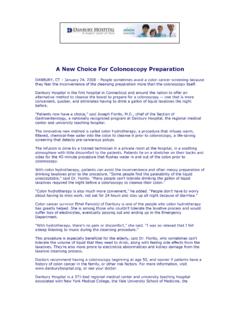
![Traditional Helath Practitioners Act [No. 35 of 2004]](/cache/preview/c/7/d/4/5/8/f/6/thumb-c7d458f692bae21cab4d196ac02eea51.jpg)
